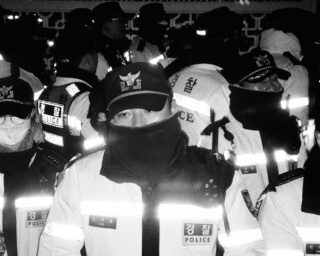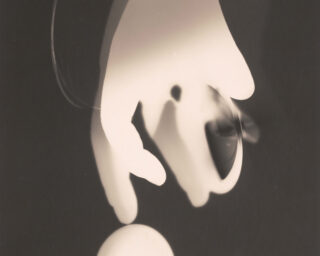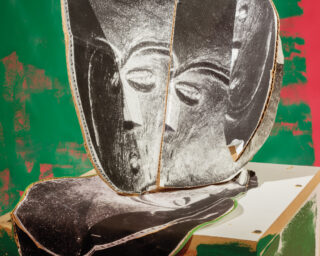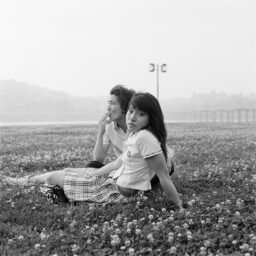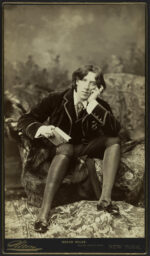The Icons by Inez & Vinoodh
This piece was originally published in Aperture Magazine issue 216, Fall 2014, Fashion.
Every fashion designer is consistently delving into the past, basing a collection on a string of memories, like shoulder pads worn by clubbers in the ’80s or the platform shoes David Bowie put on when he performed as Ziggy Stardust. Our photography stems from a similar nostalgia. Fashion is a language made up of a visual code of status symbols. We play with this code, and sometimes subvert it; without this play on references the images become too abstract. Building a character based on myriad elements—paintings, movies, music videos, pictures of your mother—is what keeps the process exciting. You might feel the references but you can’t determine their source. What follows is a selection of images by some of fashion photography’s giants, whose work has influenced four decades of fashion, photography, and advertising and has been important to the development and motivation behind our own work. One might say that in today’s professional climate, in which clients want to see their campaign images before they are even shot, you’re only as good as your references.

Richard Avedon, Verushka, dress by Bill Blass, New York, January 4, 1967 © The Richard Avedon Foundation

Richard Avedon, Nadja Auermann, Christy Turlington, Claudia Schiffer,
Cindy Crawford, and Stephanie Seymour, Versace Fall/Winter 1994–95 Campaign, New York, April 14, 1994 © The Richard Avedon Foundation
Richard Avedon
Avedon had a brilliant way of turning everyone he photographed into a hero. It was not necessarily about beautifying people, but about making them into iconic versions of themselves. He was attentive to proportion and body positioning, and able to find that one quality of someone’s physiognomy that is remarkable, whether grotesque or elegant, and bring it to the foreground. No photographer controlled body language better. Everyone is inspired by this series with Verushka, which is the epitome of movement in the studio. Almost every studio shoot today is orchestrated this way.
Avedon could translate the mood of a period but never lost his own voice. His collaboration with Versace over many years, similar to that of Yves Saint Laurent and Helmut Newton, was one of the most incredible between a designer and a photographer in which both the people and the clothing look larger than life. This photograph of five of the most beautiful women in the world is so stylized and glamorous (down to their ankle socks), yet he manages to keep their exaggerated gestures feeling candid and humorous. Apart from, of course, having the best lighting in the world, you immediately know that it’s an Avedon because the people appear magnificent. He must have been truly interested in everyone he photographed.

Guy Bourdin, Charles Jourdan, Spring, 1978 © Estate of Guy Bourdin; courtesy Michael Hoppen Gallery, London; and Art + Commerce, New York

Guy Bourdin, Charles Jourdan, Spring, 1979 © Estate of Guy Bourdin; courtesy Michael Hoppen Gallery, London; and Art + Commerce, New York
Guy Bourdain
Growing up with a mother who went to Paris twice a year to see the runway shows and who brought back issues of Vogue Paris, I (Inez) flipped through the magazine at an early age and thought that the way Helmut Newton and Guy Bourdin portrayed women was the way women were meant to be: bold, strong, wild, erotic, and independent. Bourdin definitely informed pretty much all of my early photography.
We’ve all heard the stories of how precise and demanding he was. You can tell that everything was preconceived, that it must have started with a sketch somewhere. This in-camera collage, in the picture opposite, shows how he merged abstraction with content like no one else. His consistent use of strong pink and red makeup, pale skin, and super curly hair (ideally red) has influenced many hair and makeup artists and is basically an industry standard.
Bourdin pushed his models to assume really wild expressions; sometimes he actually scared them. He must have been reacting to the ’50s, when everything had to be very perfect, proper, and clean, and then the ’60s, when everything was “peace and love.” In his work from the ’70s you feel something dubious is happening outside the frame. That dark side is inspiring, and his use of bodies, color (his painterly approach), lighting, and humor has been a big influence, especially this image, one of Bourdin’s most genius, in which a photograph of John Travolta is propped between the model’s legs. We love the use of color along with her body position. And, as in all his pictures, your eye immediately goes to the shoes.
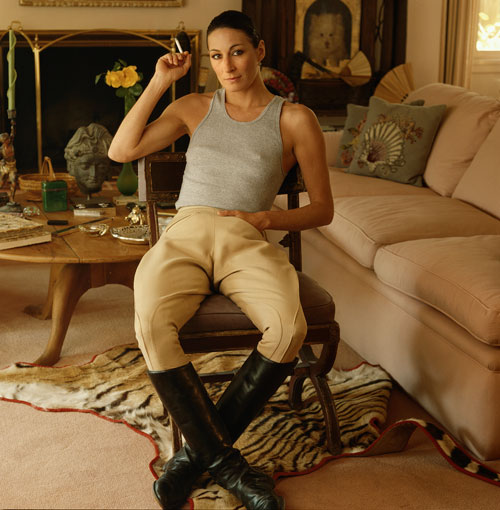
Annie Leibovitz, Anjelica Huston, 1985 © Annie Leibovitz / CONTACT PRESS IMAGES

Annie Leibovitz, Brad Pitt, Las Vegas, 1994 © Annie Leibovitz / CONTACT PRESS IMAGES
Annie Leibovitz
We saw this image of Brad Pitt for the first time at Annie’s exhibition in Stockholm, and were struck by the audacity of the leopard-print pants, the boots, the pajama shirt, the red blanket on the bed, and the nasty carpet—the sharp contrast between him and his surroundings. Annie pushes her subjects to become part of a scene or plot. Others might photograph Pitt, a male superstar, as heroic and strong, whereas here he’s passive but dressed so flamboyantly. On the other hand, Anjelica Huston wears a riding costume, looking very masculine, especially with her almost crotch-grabbing hand gesture. Anjelica has been hugely inspiring in our world, in fashion and fashion photography, for her work with Guy Bourdin, Helmut Newton, and Bob Richardson. These pictures are both portraits and fashion images. There is a simplicity to the images and their production, but the people are absolutely magnificent.
Bruce Weber, Talisa, Bellport, New York, 1982 © Bruce Weber

Bruce Weber, Gustav, Room 500, Copacabana Palace Hotel, Rio de Janeiro, 1986 © Bruce Weber
Bruce Weber
Bruce makes the most masculine men on earth look as elegant and beautiful as the most beautiful women, and he makes the most feminine women look like the strongest boys. It’s androgynous without being obviously androgynous. This image at right of Talisa, in her boxing stance, is the ultimate version of that. There is a generation that is absolutely inspired by Bruce and Herb Ritts for their interpretation of this sort of androgyny. You could say Bruce comes from the line of thought that Helmut Newton started with Yves Saint Laurent, when he set women free by using masculine codes, dressing them in tuxedos and pantsuits. We’re always trying to find a duality in a person: half male, half-female, a blurring of identity.
Bruce’s 1986 book O Rio de Janeiro has been a huge influence. His documentary approach is liberating and even stimulating. You’re in a place, you have an incredible subject, the light is the light that’s there. Now make that person incredible. That’s what we admire in Bruce’s work, that there’s no artifice. But we think that’s the bottom line for every photographer: when you’re really interested in the people you’re photographing, you get more than just the registration of someone.
David Bailey, Sharon Tate and Roman Polanski, 1969 © David Bailey
David Bailey, Jane Birkin, 1969 © David Bailey
David Bailey
Bailey was a master of freezing a moment and registering energy. In this image of Jane Birkin, the lighting is harsh and unsubtle. Bailey went after people he really wanted
to meet, or he found models on the street if he couldn’t find the right one at an agency. Humor, bravado, and flamboyance all come through in his raw, unapologetic portraiture—you sense that his models made themselves vulnerable to him. This directness is the most honest way of working with a subject. For example, if we want to shoot someone naked, we will tell them immediately. You feel that kind of directness in his work. It’s like: “This is what it is. Are you going for it? Are you submitting yourself to it? Here we go.”

Deborah Turbeville, Parco, Paris, 1986. Courtesy Staley-Wise Gallery, New York

Deborah Turbeville, Valentino, Vogue Paris, 1977. Courtesy Staley-Wise Gallery, New York
Deborah Turbeville
This image above has been in my scrapbooks ever since I (Inez) can remember looking at photography. The way the model’s head is wrapped. This decaying environment. The broken-doll position; the faded, uncanny romantic atmosphere that seems based on an old painting; the way Turbeville would lay out her books with pieces of tape stuck to her photographs—all of that influenced me. There’s a series that we did for The Face, with the model Maggie Rizer, based on this image; she had a headwrap like this girl’s.
Group shots, like the one above, are so difficult to do, at least successfully. Turbeville was a master at using negative space and catching everyone at the right moment. She must have been amazing at directing people in such a way that they would let go. Her models are often a little bit neurotic, a little on the verge of falling apart. They are unsure and unavailable, which we find attractive, but there is an incredible delicateness. We’re always amazed at how she manages to construct these group shots so beautifully, which is again a hard thing to do because you’re setting up a fashion photograph. You’re dealing with shoes and clothes. It’s incredible how she directed her subjects, and found a way to make things feel personal, as though there is complicity among the women.
Hans Feurer, Stern, 1978 Courtesy Hans Feurer / The Licensing Project
Hans Feurer
In the 1970s, Feurer opened up a studied, controlled idea of the fashion photograph while shooting for Kenzo. He worked with a long lens, at a distance, directing models with a megaphone in the early morning and at the end of the day when the light was the right temperature. Maybe using the long lens had to do with him not really wanting to engage with the women in the photographs but rather capturing them voyeuristically. The energy and the movement of the women in his photographs is sexy and creates a very unexpected body language. Women float in space in such an incredible way, showing the clothes so beautifully. When he worked with Kenzo it was a time in fashion that mixed utilitarian clothes and elegance. In this photograph at right, you’re not sure what’s going on: she’s wearing a very folkloric outfit with a military hood and gloves and mountain-climbing shoes. There are all these different messages.
This image above we honestly thought was by Guy Bourdin. But then we found out, along the way, that this was a Feurer. Let’s say there is his work with Kenzo, and then there is his work that has a sporty, fitness side to it. With this image, because of the contorted bodies and the strangeness of the composition, there is eroticism, but in his work it’s never obvious nor cheap.
______
Inez & Vinoodh are a photography duo based in New York. They guest-edited Aperture‘s “Fashion” issue.














